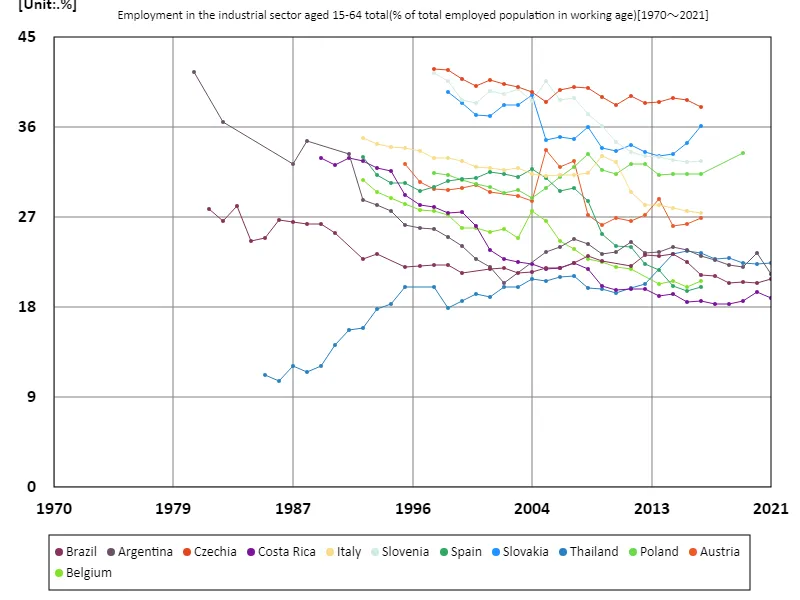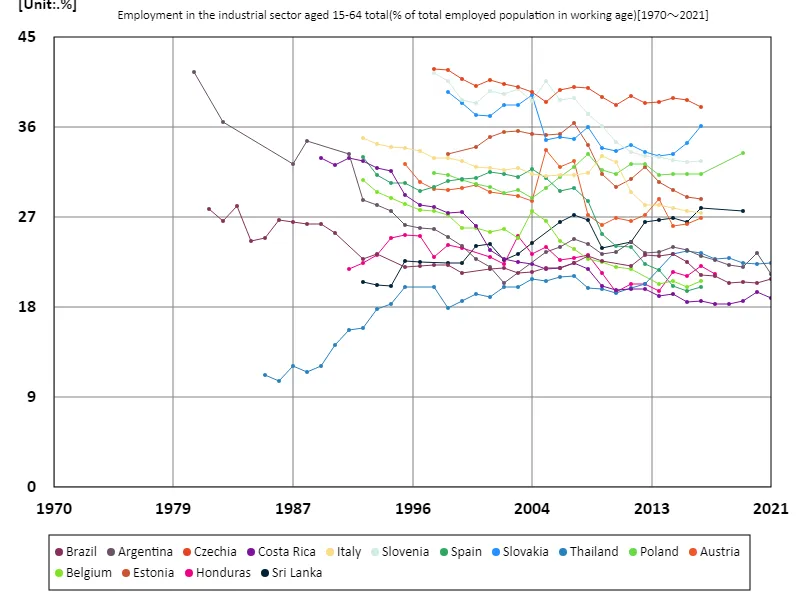- Abstract
- Employment rate for all 15-64 year olds, industrial sector (percentage of working-age population)
- Employment rate in the industrial sector for all 15-64 year olds (percentage of working-age employed population) (worldwide)
- Employment rate in the industrial sector for all 15-64 year olds (percentage of working age employed) (worldwide, latest year)
- Reference
Abstract
In recent years, Thailand has seen a steady rise in its industrial sector employment rate, reaching 22.5% in 2021 for the 15-64 age group. This reflects the country’s growing industrialization, with sectors like manufacturing, construction, and energy playing key roles in job creation. Historically, Thailand’s industrial sector has been a major driver of economic growth, shifting from agriculture-based employment to more urban, factory-based work. The high industrial employment rate is indicative of the country’s competitive labor costs and investment in infrastructure and industrial development.
Employment rate for all 15-64 year olds, industrial sector (percentage of working-age population)
The Czech Republic’s employment rate for the 15-64 age group reached a peak of 41.8% in 1997, reflecting a strong labor market during a period of post-Soviet economic transition. Since then, the rate has gradually decreased, currently standing at 91% of its peak. This shift aligns with broader global trends where many advanced economies, especially in Europe, have seen fluctuations in workforce participation due to factors like demographic aging and shifts from industrial to service-based economies. While still strong, the Czech Republic’s rate highlights ongoing challenges in sustaining high employment amidst evolving economic landscapes.


The maximum is 41.8%[1997] of Czechia, and the current value is about 91%
Employment rate in the industrial sector for all 15-64 year olds (percentage of working-age employed population) (worldwide)
The Czech Republic’s employment rate for the 15-64 age group peaked at 41.8% in 1997, reflecting a strong labor market during its transition to a market economy. Since then, the rate has declined slightly but remains at 91% of its peak, demonstrating resilience in adapting to global economic shifts. Over time, many economies, including the Czech Republic, have faced changes driven by demographic aging, technological advances, and the shift from industrial to service sectors. Despite challenges, the Czech labor market continues to perform relatively well in comparison to global trends.


The maximum is 41.8%[1997] of Czechia, and the current value is about 91%
Employment rate in the industrial sector for all 15-64 year olds (percentage of working age employed) (worldwide, latest year)
In 2021, Moldova had the highest employment rate in the industrial sector for the 15-64 age group at 27.7%, significantly above the global average of 18.6%. This highlights the country’s reliance on manufacturing and industrial jobs as key drivers of employment. The global figure of 260% reflects a broad range of industrial sector employment across different regions, showing a higher concentration in developing economies. Over time, global trends indicate a shift toward services, but Moldova’s industrial sector remains a crucial part of its economy, maintaining strong employment despite broader global shifts.


The maximum is 27.7% of Moldova, the average is 18.6%, and the total is 260%



Comments